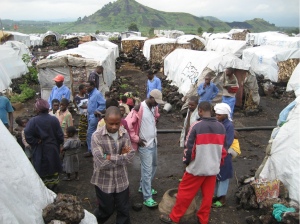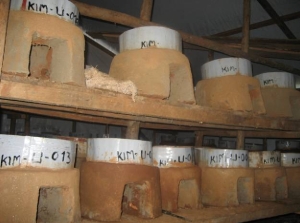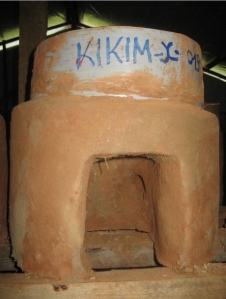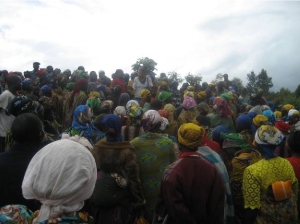
A few weeks ago a story in the Financial Times led with the stove project of Mercy Corps, a relief agency working in camp for Internally Displaced People in North Kivu, Democratic Republic of Congo.
We wanted to know more so we sent a list of questions to Elisha Moore-Delate. She is the Environment Program Manager for Mercy Corps in the Democratic Republic of Congo and the person responsible for the stoves program.
We’re sharing her inspiring and insightful responses below.

1. When, and how, did you realize that introducing energy efficient stoves would help improve conditions for the IDPs?
Energy Efficient Stoves and their need is something that has been and is easily recognized by people who witness the marginal lands where Internally Displaced Persons (IDPs) in the DRC are often placed. In this case, IDPs lived on the volcanic lava stone of two past eruptions. They have very limited earth to cultivate and very few trees (with the exception of those found in or along nearby Virunga National Park) available for families to collect as fuel wood. Charcoal, the main fuel wood substitute, is expensive and was not what was previously used by the majority of IDPs in their homes of origin.(They presumably used wood.) Thus the need for fuel efficient stoves is real and the impact of fuel savings is tangible. With fuel efficient stoves (depending on the stove type) families can often cut their fuel wood consumption in half. Our stoves have been tested and show results of fuel wood reductions by 60% among beneficiaries and 71% in our lab testing. This translates into savings all around: saving the forests and protecting a world heritage site, and saving lives put in danger during wood collection.

2. How has this project improved the lives of women, children?
It has improved their lives by reducing indoor air pollution and smoke inhalation compared to a traditional fire. It has also allowed women to spend less time on menial yet dangerous tasks such as fuel wood collection, where they must travel sometimes 14km to collect wood. It allows them to spend more time pursuing other activities that could generate income or could be spent studying or going to school. It helps people adopt more efficient methods of cooking and should overall help make their difficult lives just a small bit easier. It also provides a form of employment for more than 300 men and women who construct the stoves themselves.
3. What criteria did you use to find the right stove?
Before I started on the project, in October 2008 Mercy Corps conducted a number of cooking tests and focus groups to examine which stove type they should select. The study found that beneficiaries in the camps preferred a clay model. This was based on their prior stove experience and fear of fires- metal stoves heat up and with the small huts so close together fires can be extremely dangerous for people who have already been displaced. The people we surveyed also recognized that they wanted a stove that would hold the pot when stirring foufou, a local staple food. Unfortunately the stove model initially selected did not meet the minimal 50% wood reductions we were aiming for. When I arrived, Mercy Corps began looking at the project through a carbon reduction lens, we realized we needed a model that was more efficient but could still help us achieve our development objectives. Those objectives are 1) the inclusion and employment of women, 2) creating employment or a source of funds for IDPs who have little income and are largely dependent upon their food rations provided by the World Food Program 3) to build up capacity and skill levels of the IDPs, 4) to positively impact the environment and 5) to improve the security of the IDPs, especially women.
4. How hard or easy has it been to get the community to accept the stoves?
It was very easy for them to accept the stoves. They see the real need and welcome the opportunity to use them.
5. Did you give any consideration to implementing a briquettes program as well?
We are working with African Conservation Fund who is already implementing a briquette program here in North Kivu. Prior to the recent closure of several IDP camps, Mercy Corps and WWF were the largest consumers of briquettes because we purchased them and then Mercy Corps distributed them to 4200 vulnerable IDPs. Mercy Corps does not want to duplicate these efforts with our own briquette program. Instead we would prefer to collaborate with the existing program and strengthen their capacity to further develop the briquette market.
6. Do you think this program can be a model for displaced people elsewhere?
Other organizations are currently implementing similar stove programs for displaced people in conflict and post-conflict places, like Darfur for example. What is innovative about our program is that we combine the distribution of stoves with an agro-forestry program which allows displaced people to also access land to cultivate and increase their food security. This component provides planted trees to the owners and food for the IDPS. We also have an environmental education component that was designed to show our beneficiaries environmentally friendly ways to generate income upon their return home. It focused on composting, briquette making, permaculture, beekeeping, leguminous and arborous nursery management and animal husbandry. These activities showed IDPs and the local population who lived near the camps how it is possible to have profitable harvests on marginal lands.

7. Are there any plans to roll this out elsewhere within the Mercy Corps programs?
Yes, there are. I believe that one of Mercy Corps’ strengths is that we take each situation individually and don’t apply a cookie cutter method. Something that works in the DRC may not work exactly the same way in another country. You need to look at the culture, resources available, the environmental impact of such a program and the overall need before implementing a program. In Indonesia, for example, we have a similar stoves project, but there we’ve focused on the production of stoves and creating a market for people to sell them. The focus is more on income generation rather than immediate humanitarian needs and human security. We are also working on implementing adapted stoves projects in Uganda, East Timor and Myanmar.
8. Finally, what challenges and opportunities would you see in launching a country or region-wide energy efficient stove/kiln and sustainable biomass briquettes program?
The biggest challenge would be funding. The Congo is huge and such an operation would require funds and more than one organization to implement it. Mercy Corps is now implementing this program in four villages located in the areas where IDPs are returning home and the need for such stoves overwhelms our limited funds. The second challenge would be capacity. You need time to train staff to implement large programs and we operate in a very challenging emergency environment where it can be hard to recruit and keep good staff on board. I also don’t believe in growth just for the sake of growth. Yes, there is a real need but I also want to make sure that we can maintain the quality we seek to achieve and that we are having a real positive impact with the people who we serve here.

We wish to thank Elisha and Mercy Corps for taking the time to answer our questions!
Keep up the great work!

Kim
Photos are courtesy of Elisha Moore-Delate/ Mercy Corps
Photo of Elisha Moore-Delate (below) courtesy of Cassandra Nelson/Mercy Corps

